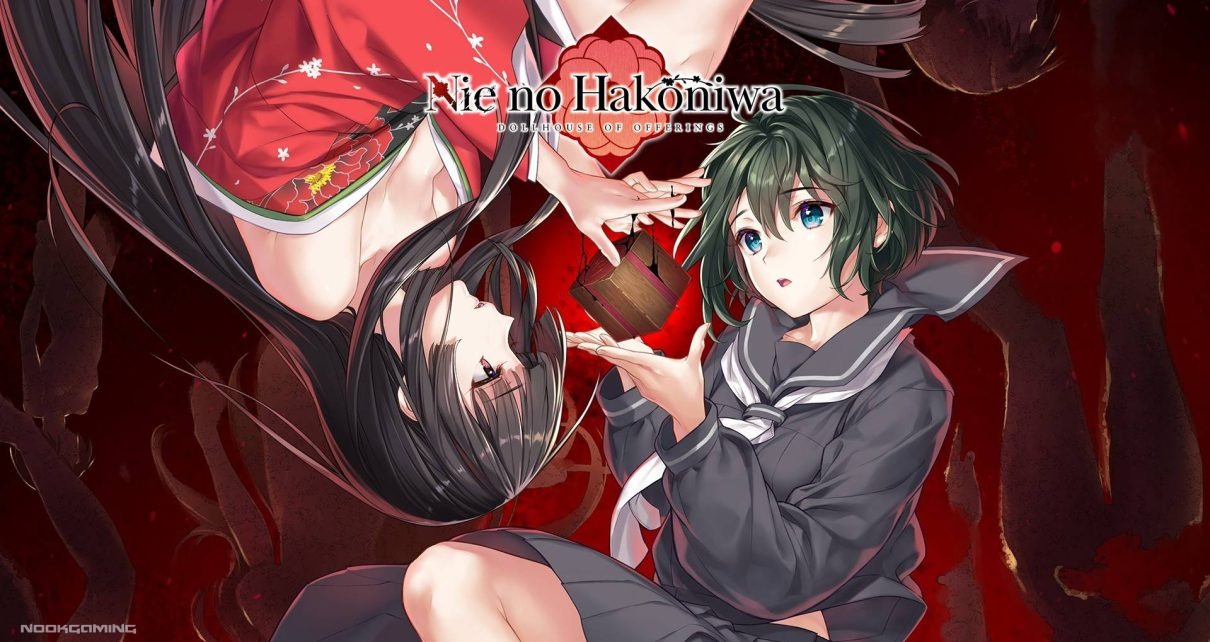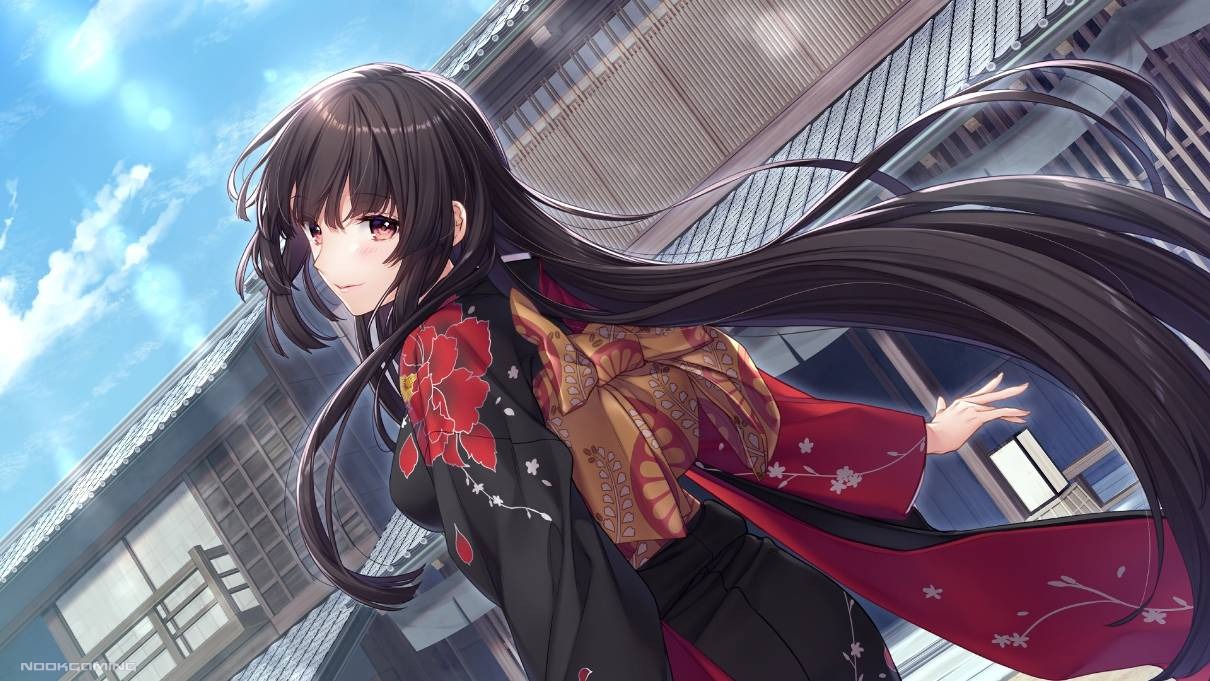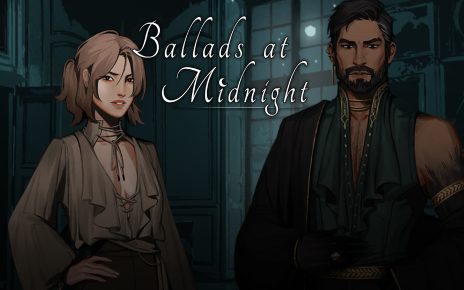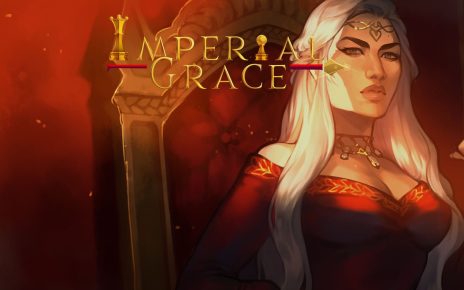Nie No Hakoniwa – Dollhouse of Offerings is a 2024 horror visual novel that features copious amounts of violence and gore. It is the debut title of Chatte Noire, an imprint of NEKO WORKs focusing on releases that depart from the trademark cute style that their parent brand employs in their visual novels. Published by Denpasoft, it is available to read in English, Japanese, and in Simplified and Traditional Chinese.
As a visual novel fan, Nie no Hakoniwa is such an interesting title to go and try out because of how different it is from the brand’s other titles. NEKO WORKs, owned by famous character designer Sayori, is primarily known for their catgirl-centric moege series NekoPara, so seeing that company spawn an imprint with a debut title full of gore was incredibly surprising to me. Additionally, despite the major shift in genre and a different artist, the promotional art seems to feature the same well-polished artstyle that Sayori employed in her previous works. How then would a title like Nie no Hakoniwa fare given NEKO WORKs’ current track record?
It’s an incredibly exciting prospect to see a company work on something presumably outside of its niche, but is that novelty all that the visual novel has to offer? With that question at the back of my mind, I opened the box.
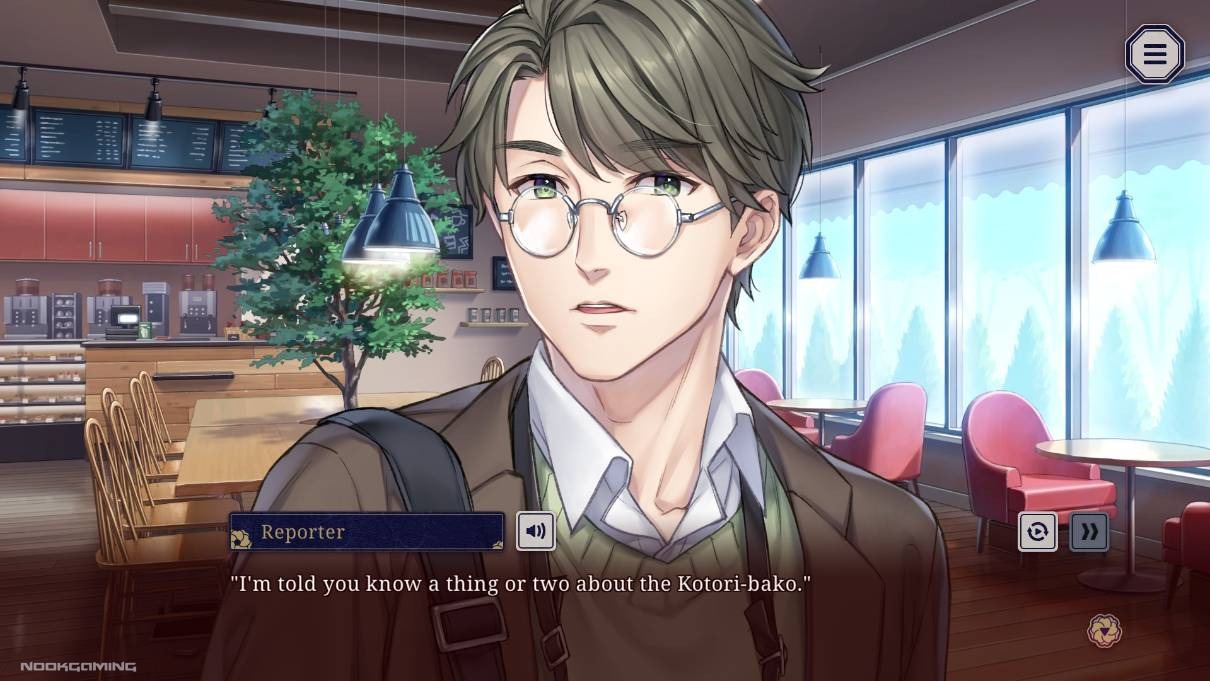
The Mystery of the Kotori-bako
Nie No Hakoniwa – Dollhouse of Offerings centers around the Kotori-bako, a puzzle box that, in Japanese horror stories, must never be opened unless you want to unleash its curse. Loosely translated as “child-stealing box”, its malice takes the form of numerous infants that twist and tear at people’s internal organs should they be unfortunate enough to be in its vicinity when opened. Women in particular are in great danger because of the cursed item’s affinity with fertile wombs. Although there is a possibility for victims to survive their encounter with the box, it’s almost certain for women to at least be barren should they survive.
The story starts off with a reporter who writes paranormal stories for a tabloid. He meets up with one of his sources who, according to him, is part of a family in possession of the Kotori-bako. She offers to tell him the story of the box passed along by members of her family, which he happily accepts for the sake of his article. From there on out, the visual novel employs a third-person narrative style, slowly fleshing out the details concerning the cursed item’s origin and a major incident related to it.
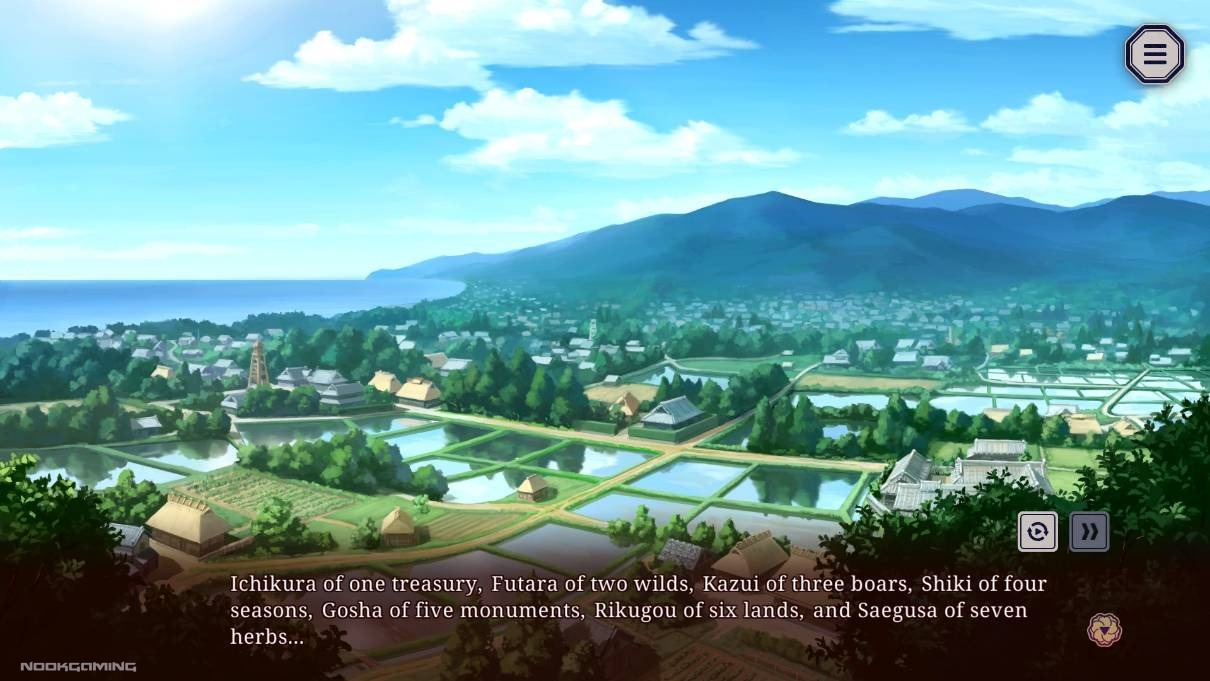
An Island with a Long History
The visual novel splits its story into three main POVs across different historical settings: the present, the Sengoku Era, and the Meiji Era. I felt that the use of multiple perspectives here helped build a solid foundation for Nie no Hakoniwa’s world-building, especially if I consider the horror story’s continuity. The text takes its time exploring the power dynamics in each historical period to set up an eventual upset of its status quo, which was really interesting to read. The prose was engaging enough to keep me interested in its colorful cast and concise enough to not feel like a drag despite the large number of introductions.
The Meiji Era is when most of the story happens. It features Yasaka Kurou, a man blessed with inhuman strength but lacking in emotion who is betrothed to the Shiki Family’s eldest daughter, Shiki Kyouko. Although unfamiliar with each other at first, they slowly close the distance between them as they conduct visits to each of the remaining members of the Seven Houses, the ruling powers of their island. Each of these families come with their own set of feelings about the marriage and move to secure their own interests in the upcoming power struggle. And on the day of Kurou and Kyouko’s marriage, the nightmare begins.
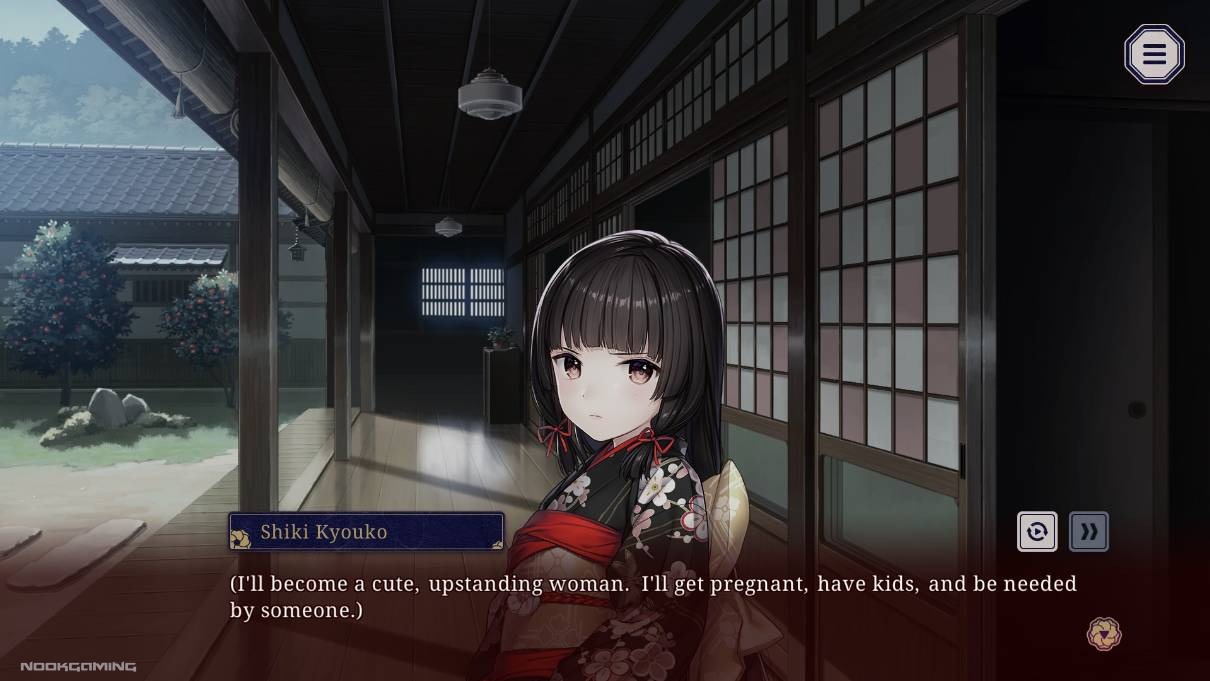
On Women and Worth
Throughout my reading, one of the most prevalent themes in Nie no Hakoniwa was the worth of a woman. In part due to being inspired by the Meiji Era, female characters in the visual novel are boxed into particular roles such as housekeeping and child-rearing and are subject to the whims of the household’s head. Should they not be able to perform these female tasks, characters around them will devalue them as people, calling them useless and whatnot. This reinforces a male-dominated narrative throughout its story, which repeatedly rears its ugly head during significant junctions in the plot.
This recurring theme, along with its historical context, become important details that support various characters’ motives throughout Nie no Hakoniwa’s narrative. It fuels their desperation, despair, happiness, and self-worth as they grapple and contend with the horror encroaching upon them. The struggle is poignant as the text wastes no opportunities to tell you how a woman’s value is non-existent should they be barren. It’s painted not as a point of contention, but as a matter of fact.
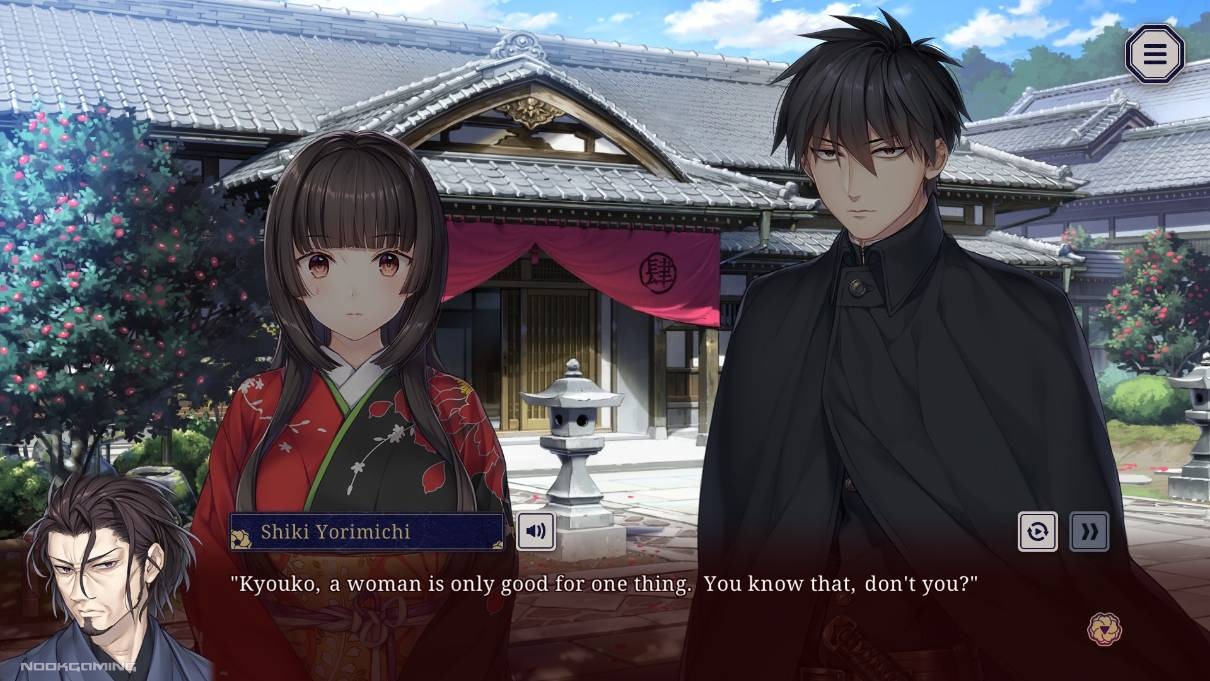
This boxing of ideas pairs really well with Kurou’s blank emotional state. As the story progresses, he’s forced to repeatedly come to terms with the realities of women’s lives in their society and his own metric of how valuable a person is. Additionally, his relationship with Kyouko further feeds into his formation, resulting in quite the unsettling character arc. I’m honestly really impressed with how they tied these together, and even more so given its role in the visual novel’s horror elements.
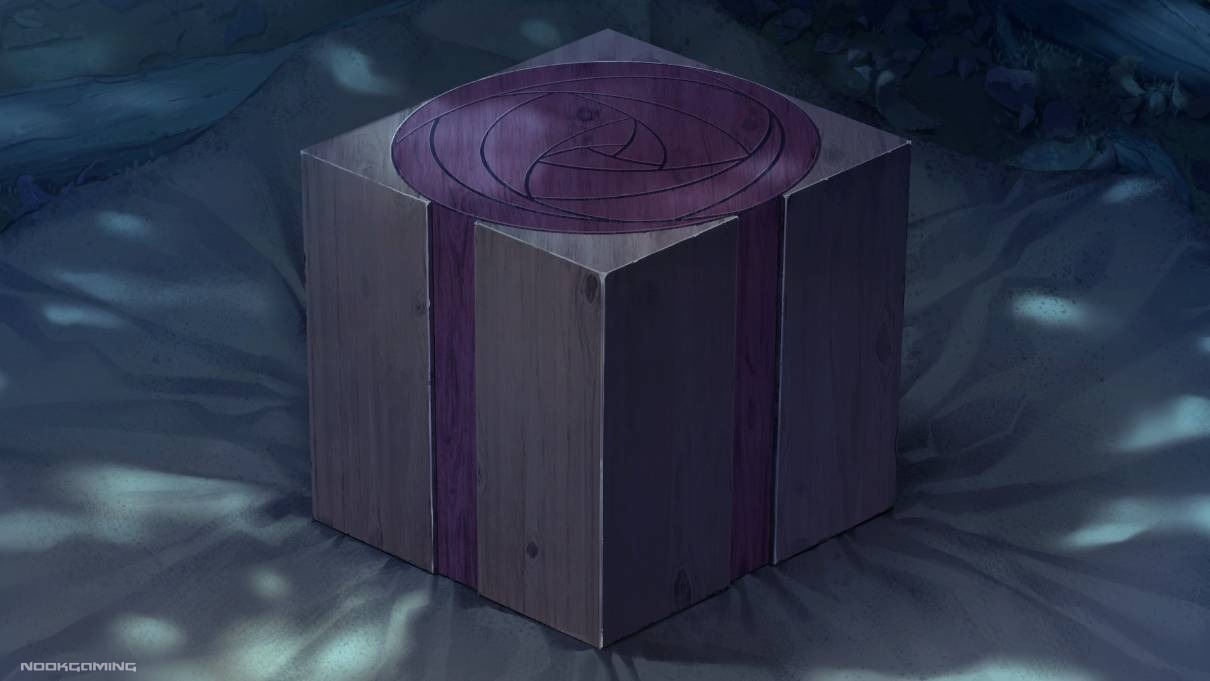
Box of Horrors
With regards to its horror aspect, Nie no Hakoniwa does a great job establishing its scare factor through anticipation. Its use of the third-person as the main reference point of the story serves it incredibly well—the text takes liberties in splitting up the story across its three POVs, withholding crucial information to tease the reader and encourage them to continue reading. The present-day point of view ends up becoming a crucial resting point between parts to help pace its narrative arc, effectively splitting the story into three tangible portions with their own climaxes and conclusions. It’s a very welcome creative decision as it not only alleviates a reader’s possible exhaustion from reading, but it gives them a chance to digest what they’ve read as well by providing space to breathe in between parts.
But going back to the visual novel’s horror elements, while the Kotori-bako itself is a pretty scary item, what I found the most unsettling in the game was the cast itself. While there are some fun quirks and banter here and there between the characters, Nie no Hakoniwa puts into the forefront the various forms human ugliness takes by painting a clear picture of each house’s obsessions. Each cost, sacrifice, and selfish decision made are detailed to an extent through the visual novel’s use of shifting perspectives. As a result, the story never truly singularly revolves around Kurou and Kyouko’s relationship; it’s accompanied by the nuances present in each house’s actions to create a tale of horror that’s largely human in origin.
The Kotori-bako as the source of the nightmare plays into this human aspect of the horror story pretty well given how it functions. Despite being a supernatural article, the conditions for its activation are dependent on external agents, specifically people who open the box. Hence, it lines up pretty well with the type of horror the story establishes, making it feel consistent and well-constructed. It doesn’t feel like a story written just for cheap thrills; the characters have actual stakes that are threatened by the narrative’s horror elements.
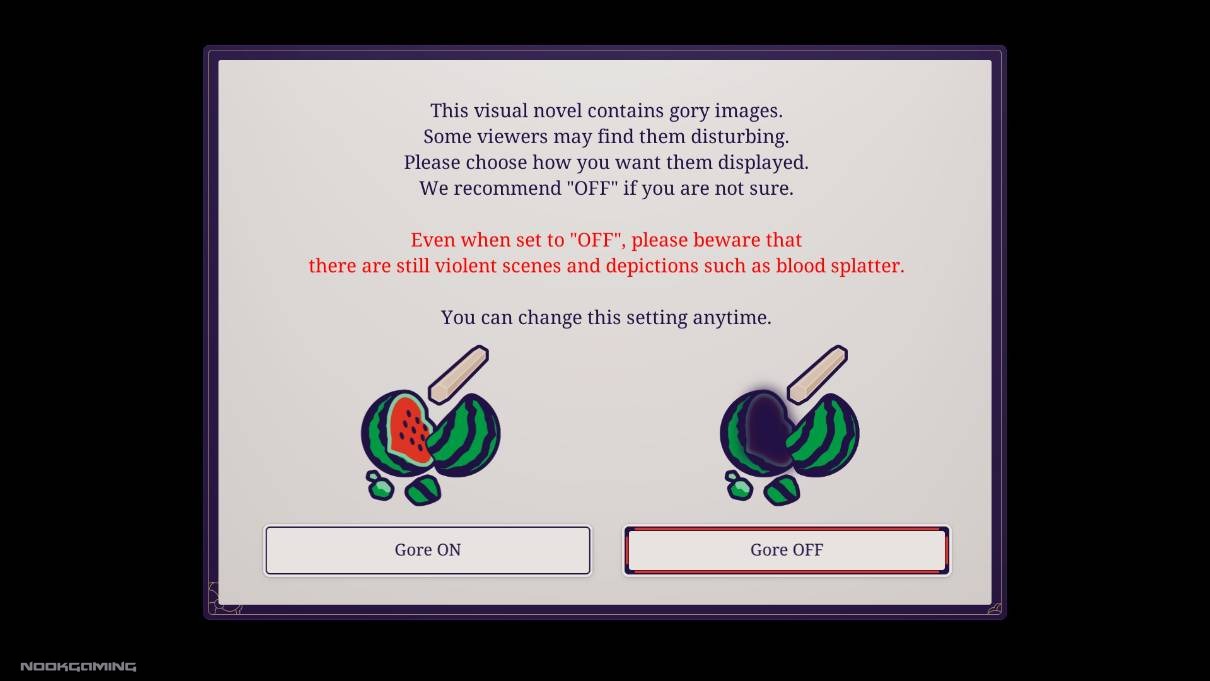
Do You Like Your Watermelons Red or Black?
When I started Nie no Hakoniwa, I was greeted by the option to turn off the gore in the visual novel’s images. This is because in addition to its horror elements, the title features extreme violence and gore in both its CGs and text which it appropriately warns potential readers about in the mature content description on its store page. Now, if you so choose to turn the gore off, the bloody parts of the images become covered by a black filter. But don’t be mistaken: while it does try to censor most of the bloody parts, the coverage is minimal at best and does not cover what isn’t easily identifiable as gore at first glance. There are still plenty of images that portray large amounts of blood, chunks of flesh, and violent acts, so tread with caution.
That being said, while the Denpasoft version contains all of the content, the Steam version of the game does come initially censored. The adult content is locked behind a patch you need to buy beforehand, and with a large part of the gore being featured in sex scenes, it effectively means that Steam’s censored version is the edition of the game with the least amount of gory imagery. I think that settling with that version, however, is a disservice to yourself.
Nie No Hakoniwa – Dollhouse of Offerings is a visual novel that revels in incredibly vivid depictions of violent and sexual acts, and while some might dismiss them as unnecessary, removing them is detrimental to the story’s horror aspect. This is a horror game that establishes fear through human cruelty; purposefully picking a censored version neuters its impact and diminishes its potential as a story.
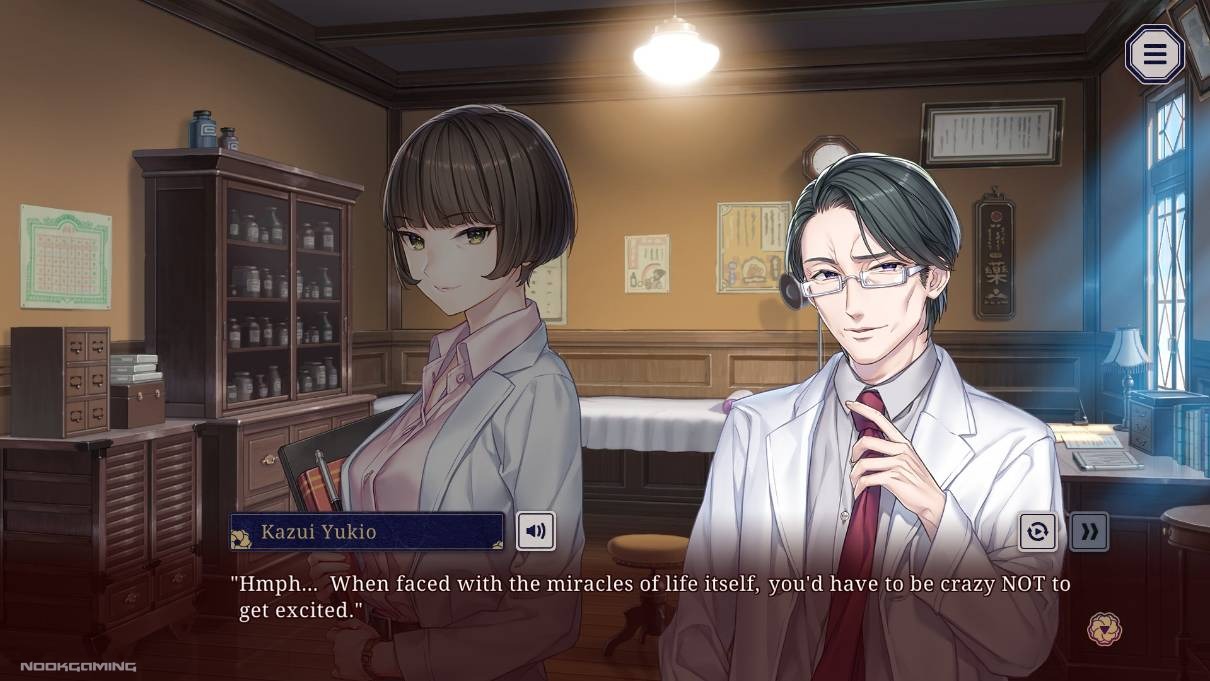
A Story for Adults
Besides Nie no Hakoniwa’s potential impact, there’s another reason why I don’t recommend going with its censored version. Of the thirteen hours I spent reading the visual novel, it feels like a large part of it was spent on adult scenes depicting violence, gore, sex, or a combination of the three. The game lists a total of twenty-one adult scenes in its gallery, which is a sizable amount for a visual novel of this length. It’s especially condensed in the second and third parts of the story, which are arguably the lead-ins for the narrative’s climax and conclusion. To paint a better picture, removing these adult scenes will make the plot progress at a speed I’m confident to say is not comfortable for readers interested in the title. The next thing you know, the box’s mysteries have all been laid bare.
This isn’t to say that the game is basically a nukige. Although it feels like that at some points with the consecutive sex scenes, most of these scenes create an urgent and threatening atmosphere instead of being fanservice fodder. I felt this was the case not only in the text itself, but in the voice acting and music they used within those scenes as well. As a reader, they were unsettling to read because of how they featured acts of cruel violence alongside sex. They fit the bill of horrific more than they do exciting.
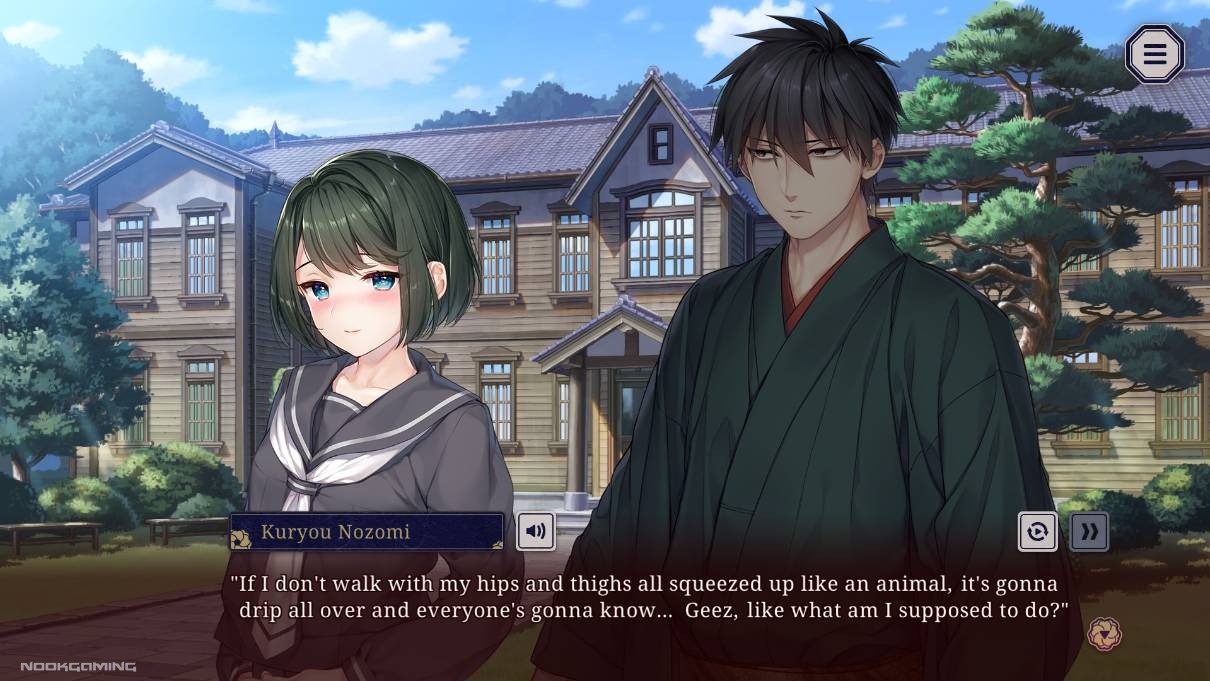
Overly Eager Dialogue
Despite having the makings of a good horror title, I feel that Nie no Hakoniwa took too many liberties in its writing. Specifically, what frustrates me about the visual novel is how characters unanimously all use rather crude imagery to describe how passionate they are about their obsessions. One repeat offender among the cast is Kuryou Nozomi, who, in most of her screen time, seems to continuously tempt Kurou’s carnal desires with her mannerisms and language. While it makes sense narrative-wise, this repeated scenario of Nozomi just being utterly horny for Kurou became boring to read towards the end. It’s not exactly motivating to read a horror visual novel when the dialogue is close to becoming nukige-tier with how much sex is being thrown around verbally.
On some occasions, the overly eager text completely breaks the atmosphere of a particular scene. Kyouko specifically has times where, despite there being hints of anxiety or sullenness, her desire for Kurou will leak out and break the scene’s buildup, leaving me rather unsatisfied. It introduces inconsistency in the writing’s tone, and quite frankly, is something that Nie no Hakoniwa could have less of. It ruins the text’s prose and ultimately makes it a worse read than what it should be.
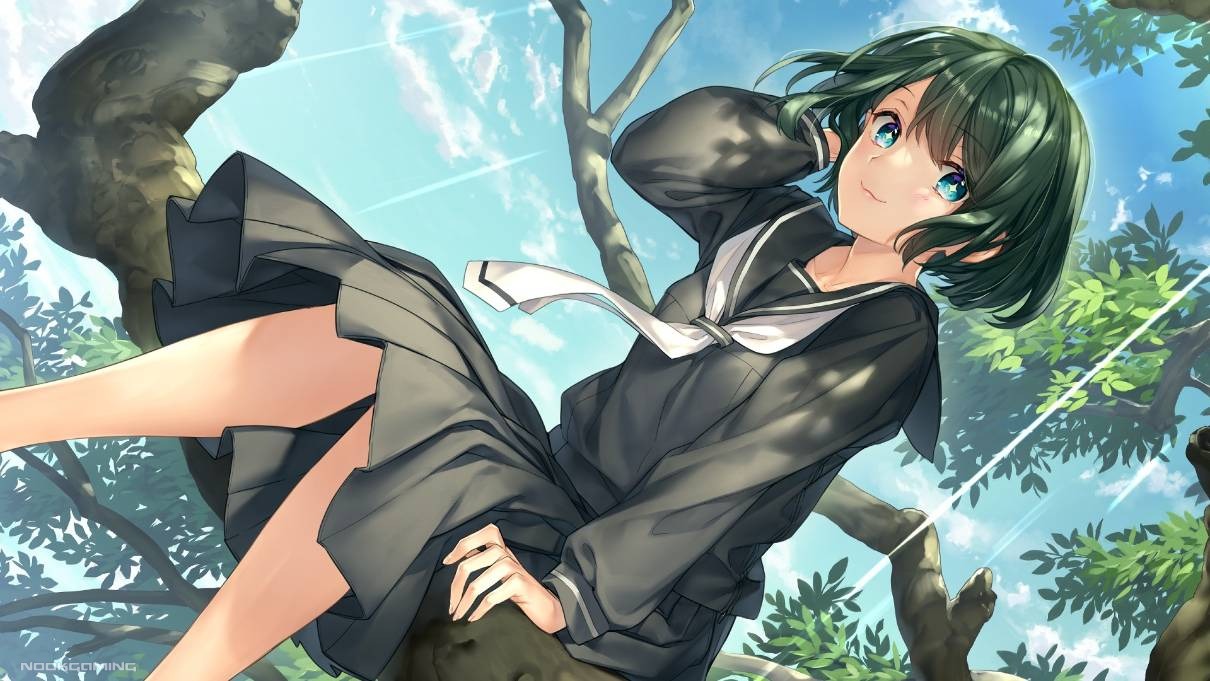
Art and Music
Nie no Hakoniwa features a total of 101 unique CGs, with two of them being bonus artworks. The art drawn by Kaguyuzu, with Sayori’s direction, is vibrant and full of life. The colors are incredibly pleasing to look at and it feels similar to the style they use in the NekoPara series. This, however, does not subtract from the more gruesome images in the game. The use of shadows and alternative sources of lighting in CGs allow the depiction of sullen and morbid situations without sacrificing the quality of their coloring. Additionally, the expressions that characters have, especially in scenes depicting extreme violence, are incredibly fitting for the visual novel. Some of their faces give hints of insanity even without text accompanying it, which speaks volumes about their attention to detail. It’s a refreshing take on their usual style and I’d love to see more from them outside of their cute niche.
The music in the visual novel is remarkable as well. Each of the noble houses and main heroines has a set of soundtracks dedicated to them, while some tracks establish the ambiance of specific backdrops the scenes are set in. None of the tracks feel off in terms of usage, and interestingly, the lack of music in some scenarios even strengthens feelings such as unease and anticipation. All in all, there are forty-five tracks in the game, with eighteen of them being ambiance tracks, As for voice acting, this is my first visual novel that heavily leans towards ryona (violence against women) and gore, so I’m not too familiar with their standards in this regard. I felt that they were good all throughout though, with their depictions of abuse being unnervingly convincing.
Verdict
Reading through Nie no Hakoniwa has been a nice change of pace from the usual eroge plagued by worn-down moe tropes and indulgent fanservice. While not exactly devoid of it, the way it approaches adult content is, for me, artistically motivated. It does feel like it’s in excess at times because of how heavily concentrated it is near the end, but I believe it serves a purpose in delivering that raw feeling of horror through over-the-top sexual violence.
I do think it’s a pity that its cohesiveness as a product is compromised by the sporadic crude creative decisions they’ve made. Despite its shortcomings, its text is engaging enough for me to lose track of time. I believe that Chatte Noire was able to break expectations with this title and establish itself as its own entity separate from NEKO WORKs’ reputation. It’s a title that’s well worth giving a try.
With beautiful artwork, great sound direction, and a cast of voice actors that give life to the nightmare, I’m happy that I gave Nie no Hakoniwa a try despite my unfamiliarity with the genre. While definitely not for the faint of heart, if you’re brave enough to make that jump and try it out, I assure you that there’s an interesting story waiting for you when you open the box.
NIE NO HAKONIWA – DOLLHOUSE OF OFFERINGS IS RECOMMENDED

Purchase Link: Denpasoft
If you are looking for another horror visual novel, you may enjoy The Song of Saya.
Many thanks go to Denpasoft for a PC review code for this title.
Visual novel reader that wishes there were more than 24 hours in a day. Gacha victim, TCG enjoyer, and VTuber simp. Still trying to live happily.

